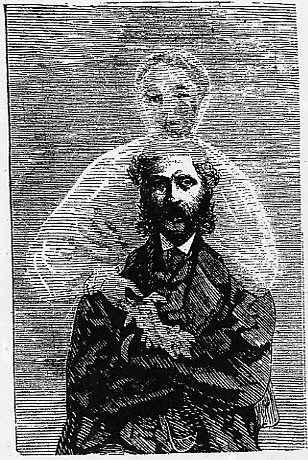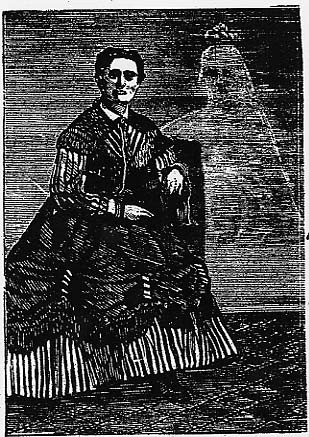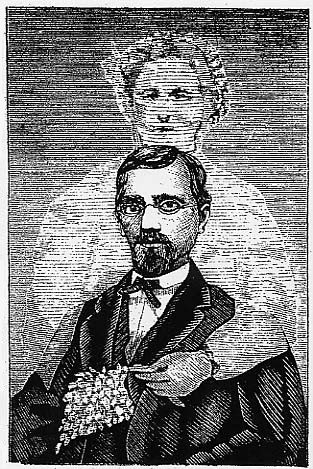Mumler and Henry Newton’s Photographic Association
Charles W. Hull, “New York Correspondence,” Philadelphia Photographer, 1869:199-203
[Note that the meeting of the New York Photographic Association, which is described in the following letter, was not chaired by its President, Henry Newton, who nevertheless was in attendance, and prepared to discuss some early experiments with dry plates treated with coffee.]
Since my last this city has been the scene of considerable excitement and interest caused by the preliminary investigation of so-called spiritual photographer.
The defendant was William H. Mumler, who claimed to have the power of calling from their repose, the sacred dead, to be by him photographed in the most bungling and inartistic style.
To the astonishment of all, Mumler not excepted, the Police Justice (Dowling) discharged the complaint instantly, on the ground that the prosecution had not proven the manner in which Mumler operated. Why did they fail in this? Because the Justice denied an order to seize the apparatus of Mumler at the time the complaint was lodged, consequently but one course was then left, and that was to prove that pictures exactly similar could be made by natural means, and that said natural means could be so used as to deceive the most shrewd and widest-awake person. Mr. Oscar G. Mason, humbugged full half a dozen, one of whom understood photography in its various details. Mr. Bogardus did the same, by no less a person than Mr. P. T. Barnum, all of whom were informed that they were to have such pictures made, and watched the whole process, from cleaning the glass to development of the negative, and failed to discover the trick; and to all of which they solemnly swore.
If such persons, who knew that a trick was to be played upon them, could not discover the means used, I would be pleased to know how any credulous individual, who fancied the room filled with all sorts of spirits; whose mind was excited by the unanticipated presence of wife, mother, or child, and who was ignorant of our art, could be expected to catch Mumler, no matter how faithfully such may have watched?
It being fully proven that sane persons could be deceived, who looked on in cool wakefulness, which, in the law, is proof against supernatural agencies, for neither statute law or common sense recognizes such, when natural means will produce similar results—in spite of which, Justice Dowling decided Mumler innocent in law, although he admits that he is “morally convinced that trickery and fraud were used.” Indeed, so far as I am able to discover, this decision not only fails o meet the case upon grounds of reasonable common sense, but fails as well to meet the views of the papers which have reviewed it, or the public who have given it a moment’s thought or attention.
The Herald terms it a “most ridiculous decision, discharging Mumler with a grand advertisement, and full freedom to inveigle all the countrymen he can into his gallery. Common sense and reality are no to be departed from, or every bedlamite can give his own crazy reasons for misconduct, and there is no safety whatever.”
It has long been held that a chain of good circumstantial evidence was enough to hang a man. It is not, in case of murder, held to be important to know just how the accused killed his victim: whether he shot him from behind a fence or a tree, or with his right hand or his left; but to prove his presence, his animus, or his advantage by the death of the one slain. It is now reversed! All, by this decision, must be positively proven, to even hold for the action of a grand jury.
All that was needed to hold Mumler, was probable cause. If such was not proven in this case, it never has, it never will be.
This decision has had, at my hands, more attention than it is worth. The Herald’s words, “most ridiculous decision,” well and aptly brands it.
These miserable photographs are so shadowy, so dim and indistinct—as will be seen by the copies which are herewith printed—that imagination of the highest order is required to detect a likeness to any one, dead or alive.
 One, of a female form (see cut) behind an innocent man in a chair, has several strange characteristics. First, it was not recognized by the man, as a portrait of his wife, until he was informed by a well-known believer that it looked like her. Then he knew it, and now swears it is good. (He is easily suited.)
One, of a female form (see cut) behind an innocent man in a chair, has several strange characteristics. First, it was not recognized by the man, as a portrait of his wife, until he was informed by a well-known believer that it looked like her. Then he knew it, and now swears it is good. (He is easily suited.)
Second. The shadow is upon the opposite side of her face from his; which, to a photographer, appears incomprehensible, but not so to Mumler & co., who say that the spirits are not subject to our laws of light, but supply their own light; are self-luminous. Well, granted. Now, if such is the case, they must emit light, and consequently have no business with any shadow. A lamp-flame is not shaded upon any side; it is luminous; and, so far as this goes, is like Mumler’s so-called “spirits.” What nonsense!
Third. The drawing is all wrong. Her right hand, in which the bouquet is held in front of him—she purporting to stand behind—would, if this was an honest picture, be elevated nearly or quite as high as his chin, from the fact, that to reach around him, it must be raised higher than shown; consequently the upper arm, from elbow to shoulder, would, in the drawing, be foreshortened, which it is not. It hangs down by her side, from shoulder to elbow. So also does her left arm. Plainly proving that this “ghost” was made up from some old picture.
Fourth. The so-called “spirits” are material or immaterial, at pleasure, Mumler says. They are seen by the camera, but not by the eye! Wonderfully strange! But how about that bouquet? That is presumed to be material. Yet, it follows, that inasmuch as the shrewd gentleman in the chair (who knows nothing of photography, yet investigated the whole matter) did not see it when within eight or ten inches of his nose, it must be like the rest of the appearance, immaterial. Query, have these so-called spirits powers to convert the corporeal to incorporeal? If so, the story of Aladdin and his wonderful lamp is no longer a fairy tale, but a fact.
Mumler presented about twenty different photographs. All the “spirits” were arrayed in the conventional shroud. Some were of children dead twenty years. One of a soldier slain in battle. Were all robed in shrouds? Doubtful. If not, where do they get them? Unless there is a place beyond this earth where shrouds can be had, they must steal them here, in which case they are bad spirits, and should not be encouraged in their visits.
The undersigned, with Messrs. Bogardus, Mason, Fredericks and Jones, visited Mumler’s place, on his promise made in court, to take anybody’s picture with the ghost in it; we, however, did not succeed in having ours made. His partner, Guay, offered to go to any gallery, on a wager of $500, and make such, but “backed out” as soon as his offer was accepted, lost his temper and his judgment, and declared he “was on the make,” and “he didn’t care a — who knew it.”
 This Mumler has a place on Broadway, up several pairs of narrow dirty stairs, where he with impudence unsurpassed, declares that he can bring upon his foul call the “just made perfect;” whose lives when on earth were pure, holy, and whose presence when in the flesh would have recoiled from such contaminating surroundings.
This Mumler has a place on Broadway, up several pairs of narrow dirty stairs, where he with impudence unsurpassed, declares that he can bring upon his foul call the “just made perfect;” whose lives when on earth were pure, holy, and whose presence when in the flesh would have recoiled from such contaminating surroundings.
Will it for an instant be believed, that people live in this century of boasted intelligence, who with serious thought indorse such preposterous claims; and seated in front of his camera await the presence by their side of the “holy dead;” and whose diseased imaginations recognize in the dimmest and most obscured outlines (see above), a likeness of those they loved on earth?
Common sense blushes in acknowledging that such people do live; and strenuously defend such claims.
Nothing would do more to make me wish that there was no future beyond the grave, than the belief that an honored and beloved father, or a sister whose saintly purity of thought and life, now lost to earth but found in heaven, were at the beck and call of any Mumler; or whose repose was subject to be disturbed by the impious summons of any mortal, whose calls were louder as his pay for such was greater; and brought into some filthy gallery, the vulgar surroundings of which would have disgusted them in life. My command of language fails to convey one tithe of the abhorrent contempt I hold for such wicked and outrageous doctrines.
To Mr. Oscar G. Mason more credit is due than has yet been given, for his ingenious labors in producing the so-called spirit pictures, especially his mica dodge, which consisted in copying through a camera any figure you might choose upon mica as a positive by transmitted light, and mounting this little piece of mica upon a stick, in the end of which is placed a pin’s point. Any photographer will at once see how easy it would be to place such a positive within the camera when focusing, so that the image would be thrown upon the sensitive plate, and to remove it when removing the plate-shield. The cut below is from one of Mr. Mason’s Photographs.
 Mr. Elbridge T. Gerry, and Assistant District Attorney Blunt, are entitled to the thanks of all, for their able and diligent prosecution of the case in behalf of the people; a case difficult in the extreme, of intricate character, and claimed supernatural surroundings. Had it come to a trial before a jury, where trick and trickery would have had to face the stern clear laws of common sense, much that is now thought wonderful, because not explained, would have been exposed, and where it would not have been allowed to ascribe to the dead any phenomena, because the living have failed in its solution.
Mr. Elbridge T. Gerry, and Assistant District Attorney Blunt, are entitled to the thanks of all, for their able and diligent prosecution of the case in behalf of the people; a case difficult in the extreme, of intricate character, and claimed supernatural surroundings. Had it come to a trial before a jury, where trick and trickery would have had to face the stern clear laws of common sense, much that is now thought wonderful, because not explained, would have been exposed, and where it would not have been allowed to ascribe to the dead any phenomena, because the living have failed in its solution.
The Photographic Section of the American Institute held its regular meeting May 4th. Mr. Abraham Bogardus, Vice-President, in the chair. Mr. Hall introduced the following, which was adopted without a dissenting voice:
WHEREAS, recent investigations before Police Justice Dowling, of so-called Spirit Photography, satisfactorily disposes of such, and at once brands the whole matter as trickery; therefore, be it
Resolved, That the Photographic Section of the American Institute take the earliest opportunity to condemn all such methods of working upon the credulous and uninitiated, and that they receive with wonder and amazement the decision of the Justice; and be it further
Resolved, That to our worthy member, Mr. P. V. Hickey, of the World, who lodged the complaint upon which the proceedings were based, we offer our thanks, for his praiseworthy though unsuccessful efforts in the cause of truth and common sense.
Mr. Kurtz exhibited a superb photograph of a lady, printed upon albumen paper, and retouched in India-ink; also a large burn-in picture, colored on porcelain.
Mr. Newton exhibited some coffee dry-plate negatives, made in fifteen seconds, with 3 ½ inch focus hemispherical lenses. He stated that he could not account for the extreme shortness of exposure, but was inclined to divide the honors between the lens and a new developer as follows, and which is to be compounded in the order given:
Water . . . . 15 ounces.
Gelatine . . . 15 grains.
Protosulphate of Iron . . 1 ounce.
Double Sulphate of Iron
and Ammonia . 1 ounce.
Glacial Acetic Acid . . 4 drachms.
Tartaric Acid . . . 15 grains.
Thirty-two drachms Acetic Acid, No. 8, will do instead of the Glacial Acetic.
Mr. Chapman stated that these coffee plates were as good as some he had prepared by the collodio-bromide of silver process, and required but half the time.
In regard to this process, Mr. Chapman said that he had placed in a window a bottle of the collodio-bromide of silver solution, where it had remained the whole of one day, one half the time being exposed to full sunshine, and that upon its removal to the dark-room, and flowing upon the plate, no difference in its working could be detected; it was as sensitive and good as other samples which had always been kept in the dark. He thought this was an argument in favor of M. Carey Lea’s theory of physical or mechanical action, in which view Professor Tillman joined him.
Mr. Boyle exhibited a telescope having two eye-pieces, intended for a comet-seeker, by which the astronomer has double the field of view. He also exhibited a superb model of the moon, nineteen inches in diameter, giving all the mountains, etc., in exact proportions to the moon’s surface. In height they are exaggerated six times. His theory, as to the composition of the moon, you have already published.
Mr. S. T. Reed stated that he had used, with marked success, two or three drops of carbolic acid to a printing-bath, which he had failed to render of use by any other means known to him.
In the hope that your readers are not more tired of this long letter than I am,
I remain, &c.,
CHAS. WAGER HULL.
::::::::::::::::::::::::::::::::::::::::::::::::
[ Photographing Heaven ] [ Ephemera Home] [![]() Photo Seance]
Photo Seance]